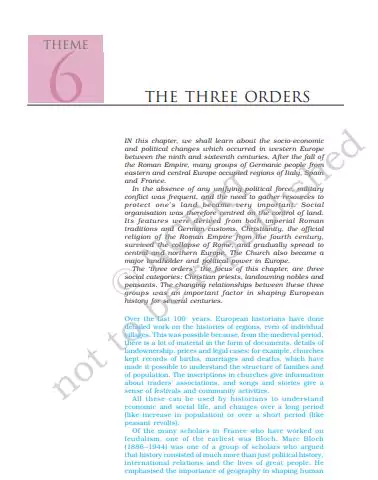‘NCERT Solutions for Class 11 History Chapter 6 The Three Orders‘ PDF Quick download link is given at the bottom of this article. You can see the PDF demo, size of the PDF, page numbers, and direct download Free PDF of ‘Ncert Class 11 History Chapter 6 Exercise Solution’ using the download button.
The Three Orders Textbook With Solution PDF Free Download

Chapter 6: The Three Orders
IN this chapter, we shall learn about the socio-economic and political changes which occurred in western Europe between the ninth and sixteenth centuries.
After the fall of the Roman Empire, many groups of Germanic people from eastern and central Europe occupied regions of Italy, Spain and France.
In the absence of any unifying political force, military conflict was frequent, and the need to gather resources to protect one’s land became very important.
Social organisation was therefore centred on the control of land. Its features were derived from both imperial Roman traditions and German customs.
Christianity, the official religion of the Roman Empire from the fourth century, survived the collapse of Rome, and gradually spread to central and northern Europe.
The Church also became a major landholder and political power in Europe.
The ‘three orders’, the focus of this chapter, are three social categories: Christian priests, landowning nobles and peasants.
The changing relationships between these three groups was an important factor in shaping European history for several centuries. Over the last 100 years, European historians have done detailed work on the histories of regions, even of individual villages.
This was possible because, from the medieval period, there is a lot of material in the form of documents, details of landownership, prices and legal cases: for example, churches kept records of births, marriages and deaths, which have made it possible to understand the structure of families and of population.
The inscriptions in churches give information about traders’ associations, and songs and stories give a sense of festivals and community activities.
All these can be used by historians to understand economic and social life, and changes over a long period (like increase in population) or over a short period (like peasant revolts).
Of the many scholars in France who have worked on feudalism, one of the earliest was Bloch.
Marc Bloch (1886–1944) was one of a group of scholars who argued that history consisted of much more than just political history, international relations and the lives of great people.
He emphasised the importance of geography in shaping human history, and the need to understand the collective behaviour or attitudes of groups of people.
Bloch’s Feudal Society is about European, particularly French, society between 900 and 1300, describing in remarkable detail social relations and hierarchies, land management and the popular culture of the period.
His career was cut short tragically when he was shot by the Nazis in the Second World War
The term ‘feudalism’ has been used by historians to describe the economic, legal, political and social relationships that existed in Europe in the medieval era.
Derived from the German word ‘feud’, which means ‘a piece of land’, it refers to the kind of society that developed in medieval France, and later in England and in southern Italy.
In an economic sense, feudalism refers to a kind of agricultural production which is based on the relationship between lords and peasants.
The latter cultivated their own land as well as that of the lord. The peasants performed labour services for the lords, who in exchange provided military protection. They also had extensive judicial control over peasants.
Thus, feudalism went beyond the economic to cover the social and political aspects of life as well.
Although its roots have been traced to practices that existed in the Roman Empire and during the age of the French king Charlemagne (742-814), feudalism as an established way of life in large parts of Europe may be said to have emerged later, in the eleventh century.
| Author | NCERT |
| Language | English |
| No. of Pages | 62 |
| PDF Size | 2.1 MB |
| Category | History |
| Source/Credits | ncert.nic.in |
NCERT Solutions Class 11 History Chapter 6 The Three Orders
Question 1.
Describe two features of early feudal society in France.
Answer:
Two features of early feudal society:
- Early feudal society in France was based on the relationship of lord and peasants. The peasants had to offer labor in the service of their lords.
- The lord enjoyed special status. His order was supreme. Nobody could deny his order.
Question 2.
How did long-term changes in population levels affect economy and society in Europe?
Answer:
Long-term changes in population levels affected the economy and society:
- This change brought about a new change in agricultural production. Production reached at its peak. Good quality of goods was also produced. It increased the life expectancy rate.
- A number of towns came into being. They also became the center of trade and commerce. Society became more advanced and civilized.
Question 3.
Why did knights become a distinct group and when did they decline?
Answer:
There were frequent localized wars in Europe during 9th century. Soldiers were not enough. Good cavalry was the need of hour. It led to the growing importance of a new section of people, i.e. the knights. They were linked to the lords.
The lord gave the knight a piece of land that was called fief. Land of the fief was cultivated by peasants. In lieu of that, the knight paid his lord a regular fee and also promised to fight for him in war. In this way, they became a distinct group. The fall of feudalism was one of the main reasons of the decline of knights during 15th century.
NCERT Class 11 History Textbook Chapter 6 The Three Orders With Answer PDF Free Download
